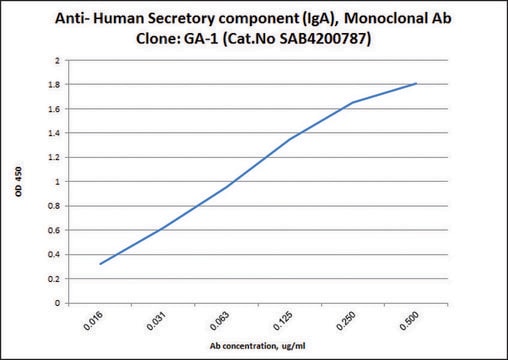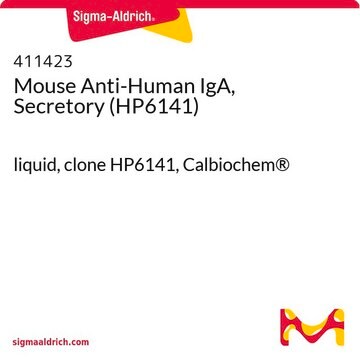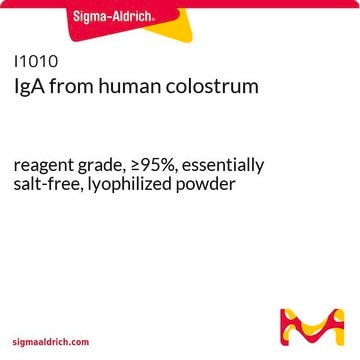MAC132
Mouse Anti-Human IgA, Secretory Antibody, Clone 4G10.1
clone 4G10.1, from mouse
Sign Into View Organizational & Contract Pricing
All Photos(1)
About This Item
UNSPSC Code:
12352203
eCl@ss:
32160702
NACRES:
NA.46
Recommended Products
biological source
mouse
Quality Level
antibody form
purified immunoglobulin
antibody product type
secondary antibodies
clone
4G10.1, monoclonal
species reactivity
human (IgA)
technique(s)
ELISA: suitable
isotype
IgG1κ
shipped in
wet ice
target post-translational modification
unmodified
General description
The Mouse Anti-Human IgA antibody is an IgG monomeric immunoglobulin, built of two heavy chains and two light chains. Each molecule has two antigen binding sites. This is the most abundant immunoglobulin and is approximately equally distributed in blood and in tissue liquids, constituting 75% of serum immunoglobulins in humans. This is the only isotype that can pass through the human placenta, thereby providing protection to the fetus in its first weeks of life before its own immune system has developed. It can bind to many kinds of pathogens, for example viruses, bacteria, and fungi, and protects the body against them by complement activation (classic pathway), opsonization for phagocytosis and neutralisation of their toxins. There are 4 subclasses: IgG1 (66%), IgG2 (23%), IgG3 (7%) and IgG4 (4%). It is affinity-purified and demonstrated to react with Human IgA with minimal or no cross-reaction to Human IgG or Human IgM. The target of this antibody, Human IgA, constitutes 5-15 % of the serum immunoglobulins whereas dimeric IgA is localized to mucosa surfaces such as saliva, gastrointestinal secretion, bronchial fluids and milk. Mucosal IgA plays a major role in host defence by neutralising infectious agents at mucosal surfaces. The production is usually local and antigen specific IgA producing B-cells can be found in regions under the lamina propria where they mature into dimeric IgA producing plasma cells. IgA deficiency is the most common immunodeficiency that may affect both serum and mucosal produced IgA.
Specificity
Based on ELISA analysis, this antibody recognizes human IgA secretory subunit, with minimal or no cross-reaction human IgG or IgM.
Immunogen
Purified antibody corresponding to Human IgA, Secretory.
Application
ELISA. Can be used as a capture antibody for ELISA at 10 μg/ml in PBS without carrier protein. Antibody should be titrated for optimal results in individual systems.
Research Category
Secondary & Control Antibodies
Secondary & Control Antibodies
Research Sub Category
Secondary Antibodies Adsorbed for Dual Labeling
Secondary Antibodies Adsorbed for Dual Labeling
This Mouse Anti-Human IgA, Secretory Antibody, Clone 4G10.1 is validated for use in Enzyme Immunoassay (ELISA) for the detection of Mouse Human IgA, Secretory.
Quality
Evaluated by ELISA against Human IgA, Human IgG and Human IgM
Linkage
Replaces: 411423-400UG
Physical form
Format: Purified
Protein G Purified
Purified mouse monoclonal IgG1κ in buffer containing PBS without preservatives.
Storage and Stability
Stable for 1 year at -20°C from date of receipt.
Other Notes
Concentration: Please refer to lot specific datasheet.
Disclaimer
Unless otherwise stated in our catalog or other company documentation accompanying the product(s), our products are intended for research use only and are not to be used for any other purpose, which includes but is not limited to, unauthorized commercial uses, in vitro diagnostic uses, ex vivo or in vivo therapeutic uses or any type of consumption or application to humans or animals.
Not finding the right product?
Try our Product Selector Tool.
Storage Class Code
12 - Non Combustible Liquids
WGK
WGK 2
Flash Point(F)
Not applicable
Flash Point(C)
Not applicable
Certificates of Analysis (COA)
Search for Certificates of Analysis (COA) by entering the products Lot/Batch Number. Lot and Batch Numbers can be found on a product’s label following the words ‘Lot’ or ‘Batch’.
Already Own This Product?
Find documentation for the products that you have recently purchased in the Document Library.
Our team of scientists has experience in all areas of research including Life Science, Material Science, Chemical Synthesis, Chromatography, Analytical and many others.
Contact Technical Service







